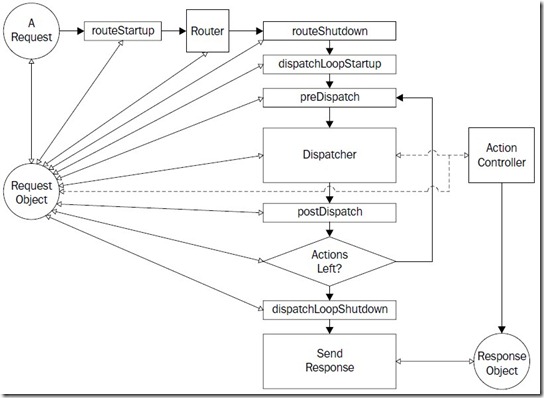您好,登錄后才能下訂單哦!
您好,登錄后才能下訂單哦!
這篇文章主要介紹Zend的MVC機制怎么用,文中介紹的非常詳細,具有一定的參考價值,感興趣的小伙伴們一定要看完!
代碼如下:
$front = Zend_Controller_Front::getInstance();
Zend_Layout::startMvc(array('layoutPath' => USVN_LAYOUTS_DIR));
$front->setRequest(new Zend_Controller_Request_Http());
$front->throwExceptions(true);
$front->setBaseUrl($config->url->base);
$router = new Zend_Controller_Router_Rewrite();
$routes_config = new USVN_Config_Ini(USVN_ROUTES_CONFIG_FILE, USVN_CONFIG_SECTION);
$router->addConfig($routes_config, 'routes');
$front->setRouter($router);
$front->setControllerDirectory(USVN_CONTROLLERS_DIR);
$front->dispatch();
把前兩句getInstance和startMvc兩個函數已經讀完了,下面是繼續分析后面的代碼
setRequest($request) 這里是判斷request是否是繼承自Zend_Controller_Request_Abstract,如果是的話就把front的_request賦值為它。
這里需要了解下什么是Zend_Controller_Request_Abstract,它是所有request抽象出來的抽象類。Zend已經提供了兩個實現類,Zend_Controller_Request_Http和Zend_Controller_Request_Simple,一般我們搭建服務器都是http請求,所以你的項目如果需要重新繼承的話,一般都直接繼承Zend_Controller_Request_Http。
Zend_controller_Request_Http中我們經常會使用到的getQuery,getCookie,getRequestUri,getBasePath,getParams,getHeader等這些Http通常的選項都已經有了。
繼續講它的基類Zend_Controller_Request_Abstract,這個類的方法包含:
回到代碼
$front->setRequest(new Zend_Controller_Request_Http());這里調用了Zend_Controller_Request_Http的構造函數,構造函數在第一次調用的時候是$this->setRequestUri();其中的setRequestUri很多都是直接使用$_SERVER這個php全局變量中的數據來獲取requestUri的。
setRequestUri可以學到的是在不同的服務器中如何獲取requestUri(特別是在IIS中的$SERVER中不同的變量組合有不同的含義),比如http://172.23.11.160/usvn/item/usvn_test 這個url,它的requestUri就是/usvn/item/usvn_test
$front->throwExceptions(true); 將內部的_throwExceptions標志位設置為true;
$front->setbaseUrl("/usvn")這個做了兩件事情,首先是設置front內部的_baseUrl屬性,其次調用Request的setBaseUrl,也是設置Zend_Controller_Request_Http的內部_baseUrl屬性。
$router = new Zend_Controller_Router_Rewrite();
$routes_config = new USVN_Config_Ini(USVN_ROUTES_CONFIG_FILE, USVN_CONFIG_SECTION);
$router->addConfig($routes_config, 'routes');
$front->setRouter($router);
下面這三行就直接說,實際上就是使用Zend的Router模塊使用配置文件,router使用setRouter放入front里面。
最后一句
$front->dispatch();
這個函數也是最核心的一個函數。
這個函數首先注冊了一個插件Zend_Controller_Plugin_ErrorHandler,index為100,把插件的順序放在最后。
第二步存放了一個Helper,Zend_Controller_Action_Helper_ViewRenderer,index為-80
下面實例化了request,request是一個Zend_Controller_Request_Http類型。并將request的baseUrl設置為前面設置過的_baseUrl,就是"/usvn/item/usvn_test"
接著實例化了response,response是一個Zend_Controller_Response_Http();
下面使用plugins來對Request和Response進行設置,首先實際調用了Zend_Controller_Plugin_Broker的setRequest函數,這個函數循環遍歷broker管理的所有插件,調用插件的setRequest($request)函數(如果有的話)。
接下來初始化router,和設置router的參數。router已經在前面設置過了,就是Zend_Controller_Router_Rewrite類型
初始化分發器dispatcher,分發器我們是第一次看到,Zend_Controller_Dispatcher_Standard類。分發器以后再說。
下面的流程:
調用插件的routeStartup對request進行處理
調用router的route處理request
調用插件的routeShutdown對request進行處理
調用插件的dispatchLoopStartup對request進行處理
進入循環分發過程
調用插件的preDispatch對request進行處理
調用dispatcher的dispatch處理request和response
調用插件的postDispatch對request進行處理
跳出循環分發過程
調用插件的dispatchLoopShutdown對request進行處理
發送response
以上是“Zend的MVC機制怎么用”這篇文章的所有內容,感謝各位的閱讀!希望分享的內容對大家有幫助,更多相關知識,歡迎關注億速云行業資訊頻道!
免責聲明:本站發布的內容(圖片、視頻和文字)以原創、轉載和分享為主,文章觀點不代表本網站立場,如果涉及侵權請聯系站長郵箱:is@yisu.com進行舉報,并提供相關證據,一經查實,將立刻刪除涉嫌侵權內容。